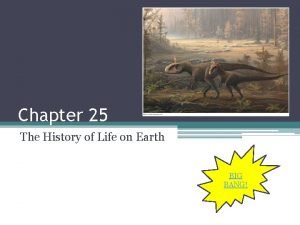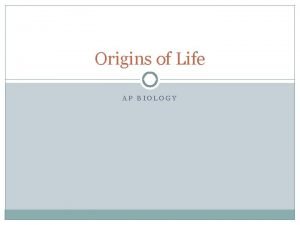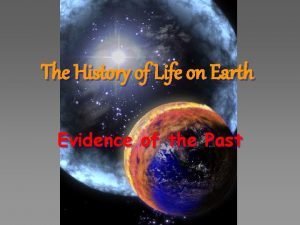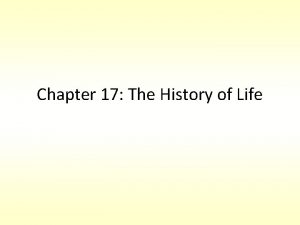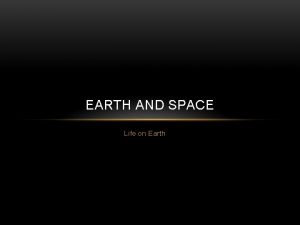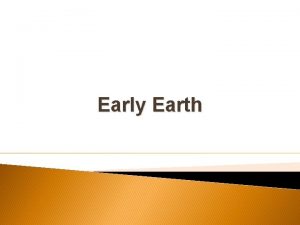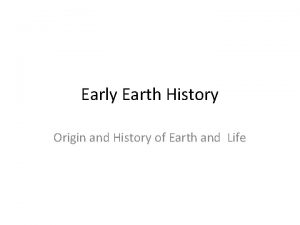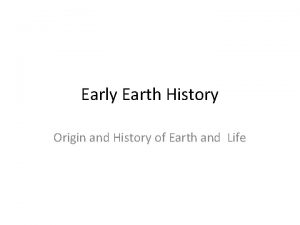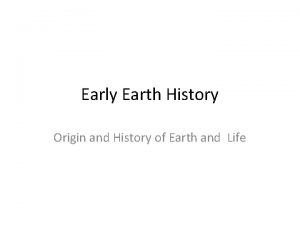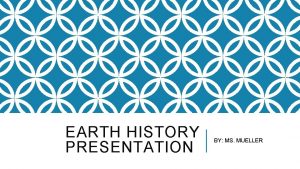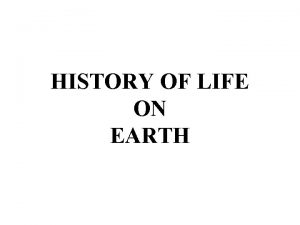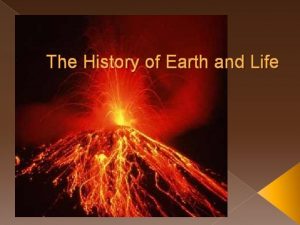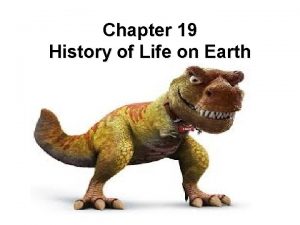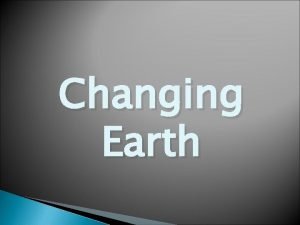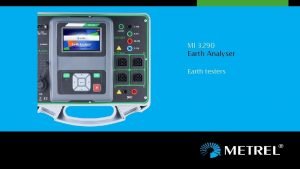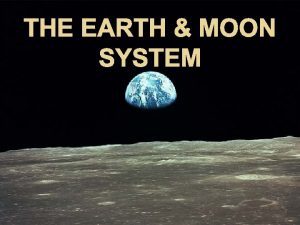CHAPTER 25 THE HISTORY OF LIFE ON EARTH
































- Slides: 32

CHAPTER 25 THE HISTORY OF LIFE ON EARTH 1

Artist’s Conception of Earth 3 billion years ago 2

3

I. Concept 25. 1: The Origin of Life A. Introduction 1. Conditions at this time on Earth were such that life could have arisen by “spontaneous generation” or abiogenesis (life developing from nonliving materials) 2. Louis Pasteur disproved spontaneous generation in 1862. 3. Today we accept theory of “biogenesis” (life comes only from preexisting life). 4. It is possible that chemical and physical processes on early Earth produced the first cells. B. Earth and other planets in the solar system formed about 4. 6 billion years ago. 4

Louis Pasteur 5

C. Current theory about how life arose consists of four main stages: 1. Abiotic synthesis of small organic molecules (monomers) 2. Joining of monomers to form macromolecules 3. Packaging of macromolecules into “protobionts, ” droplets with membranes that maintained a distinct internal chemistry 4. Origin of self-replicating molecules that eventually made inheritance possible. 6

D. Closer Look at these Four Main Stages 1. Abiotic synthesis of small organic molecules (monomers) • In the 1920’s, A. I Oparin (Russian) and J. B. S. Haldane (British) independently postulated that the conditions on early Earth (reducing environment) favored the synthesis of organic compounds from simple molecules. –Energy possibly from lightning and UV radiation • In 1953, Stanley Miller and Harold Urey tested the Oparin-Haldane hypothesis 7

• They conducted lab experiments that showed that the abiotic synthesis of organic molecules in a reducing atmosphere is possible • Atmosphere of primitive Earth: water vapor hydrogen gas methane ammonia • Used electrical sparks as source of energy 8

Miller and Urey’s Experiment 9

2. Joining of monomers to form macromolecules • Monomers could link to form macromolecules without enzymes and other cellular equipment. • Macromolecules, including polypeptides, have been produced in the lab by dripping solutions of monomers onto hot sand, clay, or rock. • These conditions are thought to be similar to early Earth at deep-sea vents or when dilute solutions of monomers splashed onto fresh lava. 10

3. Packaging of macromolecules into “protobionts, ” droplets with membranes that maintained a distinct internal chemistry • Two properties that defined life: accurate replication and metabolism • Protobionts—aggregates of abiotically produced molecules surrounded by a membrane or membranelike structure --they exhibit simple reproduction and metabolism and maintain an internal chemical environment • Can be formed spontaneously from abiotically produced organic compounds (liposomes) 11

Protobionts (Liposome) 12

4. Origin of self-replicating molecules that eventually made inheritance possible. • First genetic material was probably RNA, not DNA • RNA molecules called ribozymes can catalyze many different reactions • Has been demonstrated that RNA sequences can evolve under abiotic condition 13

Clock Analogy of Earth’s History 14

II. Concept 25. 2: Fossil Record of Life on Earth A. Sedimentary rocks are deposited into layers called strata and are the riches source of fossils. B. Methods used to date fossils and rocks: 1. Radiometric dating • Can determine absolute ages of fossils • Involves half-life of isotopes (time required for half the parent isotope to decay) 2. Radiocarbon dating (carbon-14) • Used to date fossils up to 75, 000 years old 15

III. Concept 25. 3: Major Lineages of Life A. Oldest know fossils are stromatolites, rock-like structures composed of many layers of bacteria and sediment • Date back 3. 5 billion years ago B. Prokaryotes were Earth’s sole inhabitants from 3. 5 to about 2. 1 billion years ago C. About 2. 7 billion years ago, O 2 (probably from bacteria similar to modern cyanobacteria) began accumulating in the atmosphere • Many prokaryotes were doomed by the increase in atmospheric oxygen 16

Stromatolites • 17

D. Oldest fossils of eukaryotic cells date back to 2. 1 billion years E. First Eukaryotes 1. Endosymbiosis • Proposes that mitochondria and plastids (chloroplasts and related organelles) were formerly small prokaryotes living within larger host cells • Endosymbiont—a cell that lives within a host cell • Prokaryotic ancestors of mitochondria and plastids probably gained entry to the host cell as undigested prey or internal parasites • Eventually host and endosymbiots would have become a single organism 18

• Serial endosymbiosis supposes that mitochondria evolved before plastids through a sequence of endosymbiotic events 19

2. Evidence to support an endosymbiotic origin of mitochondria and plastids: a. Similarities in inner membrane structures and functions b. Division is similar in those organelles and some prokaryotes c. Their ribosomes are more similar to prokaryotic than eukaryotic ribosomes d. Circular DNA 3. Earliest Multicellular Eukaryotes • Oldest known fossils of multicellular eukaryotes are of small algae that lived about 1. 2 billion years ago 20

IV. Concept 25. 4: Continental Drift A. Defined as the process of the Earth’s continents moving slowly over the underlying hot mantle B. Interactions between plates cause the formation of mountains and islands, and earthquakes C. Pangaea—supercontinent • Break-up lead to allopatric speciation • Current distribution of fossils reflects the movement of continental drift -Ex: the similarity of fossils in parts of South America and Africa is consistent with the idea that these continents were formerly attached 21

22

23

V. Concept 25. 5: Evolutionary Effects of Development Genes A. Genes that program development control the rate, timing, and spatial pattern of changes in an organism’s form as it develops into an adult B. Changes in Rate and Timing 1. Heterochrony • Defined as an evolutionary change in the rate or timing of developmental events • Can have a significant impact on body shape • Contrasting shapes of human and chimpanzee skulls are the result of small changes in relative growth rates 24

25

26

• Can alter the timing of reproductive development relative to the development of nonreproductive organs • In paedomorphosis, the rate of reproductive development accelerates compared with somatic development -Sexually mature species may retain body features that were juvenile structures in an ancestral species 27

Paedomorphosis 28

C. Changes in Spatial Pattern • Substantial evolutionary change can result from alterations in genes that control the placement and organization of body parts • Homeotic genes determine such basic features as where wings and leg will develop on a bird or how a flower’s parts are arranged • Hox genes are a class of homeotic genes that provide positional information during development -If expressed in the wrong location, body parts can be produced in the wrong location 29

VI. Concept 25. 6: Evolution is Not Goal Oriented (not on exam) A. Evolutionary Novelties • Evolve in many stages from previously existing structures • Complex eyes evolved from simple photosensitive cells independently many times • Exaptations are structures that evolve in one context but become co-opted for a different function • Natural selection can only improve a structure in the context of its current utility 30

You should now be able to: 1. Define radiometric dating, serial endosymbiosis, Pangaea, snowball Earth, exaptation, heterochrony, and paedomorphosis 2. Describe the contributions made by Oparin, Haldane, Miller, and Urey toward understanding the origin of organic molecules 3. List and discuss the 4 main stages of how life arose 4. Explain why RNA, not DNA, was likely the first genetic material 31

5. Describe and suggest evidence for the major events in the history of life on Earth from Earth’s origin to 2 billion years ago 6. Explain the function of Hox genes 32
 Discovery education
Discovery education Aerobic bacteria
Aerobic bacteria Tuzo wilson
Tuzo wilson Chapter 17 the history of life
Chapter 17 the history of life Hát kết hợp bộ gõ cơ thể
Hát kết hợp bộ gõ cơ thể Lp html
Lp html Bổ thể
Bổ thể Tỉ lệ cơ thể trẻ em
Tỉ lệ cơ thể trẻ em Chó sói
Chó sói Tư thế worm breton
Tư thế worm breton Chúa yêu trần thế alleluia
Chúa yêu trần thế alleluia Các môn thể thao bắt đầu bằng từ đua
Các môn thể thao bắt đầu bằng từ đua Thế nào là hệ số cao nhất
Thế nào là hệ số cao nhất Các châu lục và đại dương trên thế giới
Các châu lục và đại dương trên thế giới Cong thức tính động năng
Cong thức tính động năng Trời xanh đây là của chúng ta thể thơ
Trời xanh đây là của chúng ta thể thơ Mật thư tọa độ 5x5
Mật thư tọa độ 5x5 Làm thế nào để 102-1=99
Làm thế nào để 102-1=99 độ dài liên kết
độ dài liên kết Các châu lục và đại dương trên thế giới
Các châu lục và đại dương trên thế giới Thơ thất ngôn tứ tuyệt đường luật
Thơ thất ngôn tứ tuyệt đường luật Quá trình desamine hóa có thể tạo ra
Quá trình desamine hóa có thể tạo ra Một số thể thơ truyền thống
Một số thể thơ truyền thống Cái miệng bé xinh thế chỉ nói điều hay thôi
Cái miệng bé xinh thế chỉ nói điều hay thôi Vẽ hình chiếu vuông góc của vật thể sau
Vẽ hình chiếu vuông góc của vật thể sau Nguyên nhân của sự mỏi cơ sinh 8
Nguyên nhân của sự mỏi cơ sinh 8 đặc điểm cơ thể của người tối cổ
đặc điểm cơ thể của người tối cổ V. c c
V. c c Vẽ hình chiếu đứng bằng cạnh của vật thể
Vẽ hình chiếu đứng bằng cạnh của vật thể Vẽ hình chiếu vuông góc của vật thể sau
Vẽ hình chiếu vuông góc của vật thể sau Thẻ vin
Thẻ vin đại từ thay thế
đại từ thay thế điện thế nghỉ
điện thế nghỉ
